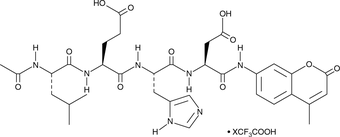Cayman
Showing 8101–8250 of 45550 results
-
AC-262536 is a selective androgen receptor modulator (SARM; Ki = 5.01 nM).{59182} It is also a partial agonist of the androgen receptor (EC50 = 1.58 nM in a luciferase assay). AC-262536 is selective for the androgen receptor over a panel of 47 additional human nuclear receptors at 10 µM. It inhibits dihydroxytestosterone-induced proliferation of LNCaP prostate cancer cells when used at concentrations of 0.1 and 1 µM. AC-262536 (3, 10, and 30 mg/kg) reduces plasma luteinizing hormone levels and increases levator ani muscle weight, a marker of anabolic activity, in castrated rats. It exhibits smaller increases in prostate gland and seminal vesicle weight, markers of androgenic activity, compared with testosterone in the same model.
Brand:CaymanSKU:31598 - 5 mgAvailable on backorder
AC-265347 is a calcimimetic and positive allosteric modulator of the calcium-sensing receptor (CaSR; EC50 = 7.94 nM in a cell-based phosphatidylinositol hydrolysis assay in the presence of calcium).{26279},{54233} It inhibits the proliferation of NIH3T3 cells expressing human CaSR (EC50 = 25.12 nM).{26279} AC-265347 reduces plasma parathyroid hormone levels in rats (ED50 = 0.01 mg/kg).
Brand:CaymanSKU:30937 - 1 mgAvailable on backorder
AC-265347 is a calcimimetic and positive allosteric modulator of the calcium-sensing receptor (CaSR; EC50 = 7.94 nM in a cell-based phosphatidylinositol hydrolysis assay in the presence of calcium).{26279},{54233} It inhibits the proliferation of NIH3T3 cells expressing human CaSR (EC50 = 25.12 nM).{26279} AC-265347 reduces plasma parathyroid hormone levels in rats (ED50 = 0.01 mg/kg).
Brand:CaymanSKU:30937 - 5 mgAvailable on backorder
AC-5216 is a high affinity agonist of the 18 kDa translocator protein (TSPO, previously called the peripheral benzodiazepine receptor) that exhibits a Ki value of 0.297 nM in rat whole brain and IC50 values of 2.73 and 3.04 nM, respectively, against human and rat glial TSPO.{29754} AC-5216 produces anxiolytic and antidepressant effects in various animal models, without inducing benzodiazepine-like adverse effects.{29754,29755}
Brand:CaymanSKU:-Available on backorder
AC-5216 is a high affinity agonist of the 18 kDa translocator protein (TSPO, previously called the peripheral benzodiazepine receptor) that exhibits a Ki value of 0.297 nM in rat whole brain and IC50 values of 2.73 and 3.04 nM, respectively, against human and rat glial TSPO.{29754} AC-5216 produces anxiolytic and antidepressant effects in various animal models, without inducing benzodiazepine-like adverse effects.{29754,29755}
Brand:CaymanSKU:-Available on backorder
AC-5216 is a high affinity agonist of the 18 kDa translocator protein (TSPO, previously called the peripheral benzodiazepine receptor) that exhibits a Ki value of 0.297 nM in rat whole brain and IC50 values of 2.73 and 3.04 nM, respectively, against human and rat glial TSPO.{29754} AC-5216 produces anxiolytic and antidepressant effects in various animal models, without inducing benzodiazepine-like adverse effects.{29754,29755}
Brand:CaymanSKU:-Available on backorder
AC-55541 is a proteinase-activated receptor 2 (PAR2) agonist that displays no activity at other PAR subtypes or at over 30 other receptors involved in nociception and inflammation.{30968} It stimulates cell proliferation, phosphatidylinositol hydrolysis, and calcium mobilization in in vitro functional assays (pEC50s = 6.7, 5.9, and 6.6, respectively).{30968} Intrapaw administration of 3-10 mg/kg AC-55541 elicited pronociceptive activity in vivo.{30968}
Brand:CaymanSKU:-Available on backorder
AC-55541 is a proteinase-activated receptor 2 (PAR2) agonist that displays no activity at other PAR subtypes or at over 30 other receptors involved in nociception and inflammation.{30968} It stimulates cell proliferation, phosphatidylinositol hydrolysis, and calcium mobilization in in vitro functional assays (pEC50s = 6.7, 5.9, and 6.6, respectively).{30968} Intrapaw administration of 3-10 mg/kg AC-55541 elicited pronociceptive activity in vivo.{30968}
Brand:CaymanSKU:-Available on backorder
AC-55541 is a proteinase-activated receptor 2 (PAR2) agonist that displays no activity at other PAR subtypes or at over 30 other receptors involved in nociception and inflammation.{30968} It stimulates cell proliferation, phosphatidylinositol hydrolysis, and calcium mobilization in in vitro functional assays (pEC50s = 6.7, 5.9, and 6.6, respectively).{30968} Intrapaw administration of 3-10 mg/kg AC-55541 elicited pronociceptive activity in vivo.{30968}
Brand:CaymanSKU:-Available on backorder
AC-55541 is a proteinase-activated receptor 2 (PAR2) agonist that displays no activity at other PAR subtypes or at over 30 other receptors involved in nociception and inflammation.{30968} It stimulates cell proliferation, phosphatidylinositol hydrolysis, and calcium mobilization in in vitro functional assays (pEC50s = 6.7, 5.9, and 6.6, respectively).{30968} Intrapaw administration of 3-10 mg/kg AC-55541 elicited pronociceptive activity in vivo.{30968}
Brand:CaymanSKU:-Available on backorder
AC-710 is an inhibitor of PDGFR family kinases (IC50s = 7.7, 10.5, 2, and 1.2 nM for PDGFRβ, CSF1R, FLT3, and c-Kit, respectively).{53181} It is greater than 30-fold selective for PDGFR family kinases over a panel of 386 kinases, as well as over a panel of five cytochrome P450 (CYP) enzymes (IC50s = >40 µM). AC-710 (30 mg/kg) inhibits CSF1R-dependent M-NFS-60 murine leukemia cell proliferation and reduces tumor volume in an FLT3 mutant MV4-11 leukemia mouse xenograft model.
Brand:CaymanSKU:29498 - 1 mgAvailable on backorder
AC-710 is an inhibitor of PDGFR family kinases (IC50s = 7.7, 10.5, 2, and 1.2 nM for PDGFRβ, CSF1R, FLT3, and c-Kit, respectively).{53181} It is greater than 30-fold selective for PDGFR family kinases over a panel of 386 kinases, as well as over a panel of five cytochrome P450 (CYP) enzymes (IC50s = >40 µM). AC-710 (30 mg/kg) inhibits CSF1R-dependent M-NFS-60 murine leukemia cell proliferation and reduces tumor volume in an FLT3 mutant MV4-11 leukemia mouse xenograft model.
Brand:CaymanSKU:29498 - 10 mgAvailable on backorder
AC-710 is an inhibitor of PDGFR family kinases (IC50s = 7.7, 10.5, 2, and 1.2 nM for PDGFRβ, CSF1R, FLT3, and c-Kit, respectively).{53181} It is greater than 30-fold selective for PDGFR family kinases over a panel of 386 kinases, as well as over a panel of five cytochrome P450 (CYP) enzymes (IC50s = >40 µM). AC-710 (30 mg/kg) inhibits CSF1R-dependent M-NFS-60 murine leukemia cell proliferation and reduces tumor volume in an FLT3 mutant MV4-11 leukemia mouse xenograft model.
Brand:CaymanSKU:29498 - 25 mgAvailable on backorder
AC-710 is an inhibitor of PDGFR family kinases (IC50s = 7.7, 10.5, 2, and 1.2 nM for PDGFRβ, CSF1R, FLT3, and c-Kit, respectively).{53181} It is greater than 30-fold selective for PDGFR family kinases over a panel of 386 kinases, as well as over a panel of five cytochrome P450 (CYP) enzymes (IC50s = >40 µM). AC-710 (30 mg/kg) inhibits CSF1R-dependent M-NFS-60 murine leukemia cell proliferation and reduces tumor volume in an FLT3 mutant MV4-11 leukemia mouse xenograft model.
Brand:CaymanSKU:29498 - 5 mgAvailable on backorder
Ac-Asp(OtBu)-OH is an amino acid-containing building block.{52513,52514,52515} It has been used in the synthesis of caspase-3 and -7 peptide substrates and inhibitors, as well as peptide inhibitors of HIV integrase.
Brand:CaymanSKU:30539 - 1 gAvailable on backorder
Ac-Asp(OtBu)-OH is an amino acid-containing building block.{52513,52514,52515} It has been used in the synthesis of caspase-3 and -7 peptide substrates and inhibitors, as well as peptide inhibitors of HIV integrase.
Brand:CaymanSKU:30539 - 500 mgAvailable on backorder
The calpains are a family of calcium-dependent cysteine proteases, with calpain I (µ-calpain) requiring micromolar calcium and calpain II (m-calpain) requiring millimolar calcium.{27072} Ac-calpastatin (184-210) is an acetylated synthetic peptide from human calpastatin that strongly inhibits both calpains I and II but not papain (a cysteine protease) or trypsin (a serine protease).{13824} This 27 amino acid peptide is encoded by exon 1B of Ac-calpastatin (184-210) and corresponds to a portion of inhibitory domain 1.{13824,13828}
Brand:CaymanSKU:-Out of stock
The calpains are a family of calcium-dependent cysteine proteases, with calpain I (µ-calpain) requiring micromolar calcium and calpain II (m-calpain) requiring millimolar calcium.{27072} Ac-calpastatin (184-210) is an acetylated synthetic peptide from human calpastatin that strongly inhibits both calpains I and II but not papain (a cysteine protease) or trypsin (a serine protease).{13824} This 27 amino acid peptide is encoded by exon 1B of Ac-calpastatin (184-210) and corresponds to a portion of inhibitory domain 1.{13824,13828}
Brand:CaymanSKU:-Out of stock
The calpains are a family of calcium-dependent cysteine proteases, with calpain I (µ-calpain) requiring micromolar calcium and calpain II (m-calpain) requiring millimolar calcium.{27072} Ac-calpastatin (184-210) is an acetylated synthetic peptide from human calpastatin that strongly inhibits both calpains I and II but not papain (a cysteine protease) or trypsin (a serine protease).{13824} This 27 amino acid peptide is encoded by exon 1B of Ac-calpastatin (184-210) and corresponds to a portion of inhibitory domain 1.{13824,13828}
Brand:CaymanSKU:-Out of stock
During apoptosis, activated caspase-3 cleaves several substrates, including poly(ADP-ribose) polymerase, which it specifically targets at the amino sequence DEVD.{22861} Ac-DEVD-AFC is a fluorogenic substrate for activated caspase-3 (Km = 9.7 µM), as well as related caspases.{22863,6382,22862} Caspase activity can be quantified by fluorescent detection of free AFC (also known as 7-amino-4-trifluoromethylcoumarin), which is excited at 400 nm and emits at 505 nm.
Brand:CaymanSKU:-During apoptosis, activated caspase-3 cleaves several substrates, including poly(ADP-ribose) polymerase, which it specifically targets at the amino sequence DEVD.{22861} Ac-DEVD-AFC is a fluorogenic substrate for activated caspase-3 (Km = 9.7 µM), as well as related caspases.{22863,6382,22862} Caspase activity can be quantified by fluorescent detection of free AFC (also known as 7-amino-4-trifluoromethylcoumarin), which is excited at 400 nm and emits at 505 nm.
Brand:CaymanSKU:-During apoptosis, activated caspase-3 cleaves several substrates, including poly(ADP-ribose) polymerase, which it specifically targets at the amino sequence DEVD.{22861} Ac-DEVD-AFC is a fluorogenic substrate for activated caspase-3 (Km = 9.7 µM), as well as related caspases.{22863,6382,22862} Caspase activity can be quantified by fluorescent detection of free AFC (also known as 7-amino-4-trifluoromethylcoumarin), which is excited at 400 nm and emits at 505 nm.
Brand:CaymanSKU:-Ac-DEVD-AMC is a fluorogenic substrate that can be cleaved specifically by caspase-3.{13020} Caspase activity can be quantified by fluorescent detection of free AMC (also known as 7-amino-4-methylcoumarin), which is excited at 340-360 nm and emits at 440-460 nm.
Brand:CaymanSKU:-Ac-DEVD-AMC is a fluorogenic substrate that can be cleaved specifically by caspase-3.{13020} Caspase activity can be quantified by fluorescent detection of free AMC (also known as 7-amino-4-methylcoumarin), which is excited at 340-360 nm and emits at 440-460 nm.
Brand:CaymanSKU:-Ac-DEVD-AMC is a fluorogenic substrate that can be cleaved specifically by caspase-3.{13020} Caspase activity can be quantified by fluorescent detection of free AMC (also known as 7-amino-4-methylcoumarin), which is excited at 340-360 nm and emits at 440-460 nm.
Brand:CaymanSKU:-Ac-DEVD-CHO is a potent inhibitor of the Group II caspases, caspase-3 and caspase-7 (Kis = 0.23 and 1.6 nM, respectively).{7777,7213} Notably, it also inhibits other caspases (Kis = 18, 1710, 132, 205, 31, 0.92, 60, and 12 nM for caspases-1, -2, -4, -5, -6, -8, -9, and -10, respectively).{7777} Caspase inhibitors in the aldehyde form, like this compound, are typically reversible, whereas methyl ketone forms, like Ac-DEVD-CMK (Item No. 14465), are irreversible.{7777} Caspase inhibitors interfere with the initiation of apoptosis and have numerous possible clinical applications.{10070}
Brand:CaymanSKU:10017 - 1 mgAvailable on backorder
Ac-DEVD-CHO is a potent inhibitor of the Group II caspases, caspase-3 and caspase-7 (Kis = 0.23 and 1.6 nM, respectively).{7777,7213} Notably, it also inhibits other caspases (Kis = 18, 1710, 132, 205, 31, 0.92, 60, and 12 nM for caspases-1, -2, -4, -5, -6, -8, -9, and -10, respectively).{7777} Caspase inhibitors in the aldehyde form, like this compound, are typically reversible, whereas methyl ketone forms, like Ac-DEVD-CMK (Item No. 14465), are irreversible.{7777} Caspase inhibitors interfere with the initiation of apoptosis and have numerous possible clinical applications.{10070}
Brand:CaymanSKU:10017 - 10 mgAvailable on backorder
Ac-DEVD-CHO is a potent inhibitor of the Group II caspases, caspase-3 and caspase-7 (Kis = 0.23 and 1.6 nM, respectively).{7777,7213} Notably, it also inhibits other caspases (Kis = 18, 1710, 132, 205, 31, 0.92, 60, and 12 nM for caspases-1, -2, -4, -5, -6, -8, -9, and -10, respectively).{7777} Caspase inhibitors in the aldehyde form, like this compound, are typically reversible, whereas methyl ketone forms, like Ac-DEVD-CMK (Item No. 14465), are irreversible.{7777} Caspase inhibitors interfere with the initiation of apoptosis and have numerous possible clinical applications.{10070}
Brand:CaymanSKU:10017 - 5 mgAvailable on backorder
Ac-DEVD-CHO is a potent inhibitor of the Group II caspases, caspase-3 and caspase-7 (Kis = 0.23 and 1.6 nM, respectively).{7777,7213} Notably, it also inhibits other caspases (Kis = 18, 1710, 132, 205, 31, 0.92, 60, and 12 nM for caspases-1, -2, -4, -5, -6, -8, -9, and -10, respectively).{7777} Caspase inhibitors in the aldehyde form, like this compound, are typically reversible, whereas methyl ketone forms, like Ac-DEVD-CMK (Item No. 14465), are irreversible.{7777} Caspase inhibitors interfere with the initiation of apoptosis and have numerous possible clinical applications.{10070}
Brand:CaymanSKU:10017 - 500 µgAvailable on backorder
Ac-DEVD-CMK is a cell-permeable, and irreversible inhibitor of caspase-3 as well as caspase-6, -7, -8, and -10.{22842,22843,6769} It is commonly used at concentrations up to 100 μM to examine the role of caspase-3-dependent apoptosis in biological systems.{22841,22842}
Brand:CaymanSKU:-Ac-DEVD-CMK is a cell-permeable, and irreversible inhibitor of caspase-3 as well as caspase-6, -7, -8, and -10.{22842,22843,6769} It is commonly used at concentrations up to 100 μM to examine the role of caspase-3-dependent apoptosis in biological systems.{22841,22842}
Brand:CaymanSKU:-During apoptosis, activated caspase-3 cleaves several substrates, including poly(ADP-ribose) polymerase, which it specifically targets at the amino sequence DEVD.{22861} Ac-DEVD-pNA is a para-nitro aniline chromophore cleaved by caspases (Km = 18, 11, 32, 180, and 12 µM for caspases-1, -3, -4, -6, and -7, respectively).{7213} It is not cleaved by caspase-2.{7213} Cleavage is monitored colorimetrically at 405 nm.
Brand:CaymanSKU:-During apoptosis, activated caspase-3 cleaves several substrates, including poly(ADP-ribose) polymerase, which it specifically targets at the amino sequence DEVD.{22861} Ac-DEVD-pNA is a para-nitro aniline chromophore cleaved by caspases (Km = 18, 11, 32, 180, and 12 µM for caspases-1, -3, -4, -6, and -7, respectively).{7213} It is not cleaved by caspase-2.{7213} Cleavage is monitored colorimetrically at 405 nm.
Brand:CaymanSKU:-During apoptosis, activated caspase-3 cleaves several substrates, including poly(ADP-ribose) polymerase, which it specifically targets at the amino sequence DEVD.{22861} Ac-DEVD-pNA is a para-nitro aniline chromophore cleaved by caspases (Km = 18, 11, 32, 180, and 12 µM for caspases-1, -3, -4, -6, and -7, respectively).{7213} It is not cleaved by caspase-2.{7213} Cleavage is monitored colorimetrically at 405 nm.
Brand:CaymanSKU:-Ac-DNLD-AMC is a fluorogenic caspase-3 substrate.{39492} Upon enzymatic cleavage by caspase-3, 7-amino-4-methylcoumarin (AMC) is released and its fluorescence can be used to quantify caspase-3 activity. AMC displays excitation/emission maxima of 340-360 and 440-460 nm, respectively.
Brand:CaymanSKU:24566 - 1 mgAvailable on backorder
Ac-DNLD-AMC is a fluorogenic caspase-3 substrate.{39492} Upon enzymatic cleavage by caspase-3, 7-amino-4-methylcoumarin (AMC) is released and its fluorescence can be used to quantify caspase-3 activity. AMC displays excitation/emission maxima of 340-360 and 440-460 nm, respectively.
Brand:CaymanSKU:24566 - 500 µgAvailable on backorder
Ac-Gly-Lys-OMe is a synthetic peptide urokinase substrate.{53643,53642} It has been used to characterize the effects of small molecule inhibitors and metal ions on urokinase activity in cell-free assays.
Brand:CaymanSKU:30568 - 10 mgAvailable on backorder
Ac-Gly-Lys-OMe is a synthetic peptide urokinase substrate.{53643,53642} It has been used to characterize the effects of small molecule inhibitors and metal ions on urokinase activity in cell-free assays.
Brand:CaymanSKU:30568 - 100 mgAvailable on backorder
Ac-Gly-Lys-OMe is a synthetic peptide urokinase substrate.{53643,53642} It has been used to characterize the effects of small molecule inhibitors and metal ions on urokinase activity in cell-free assays.
Brand:CaymanSKU:30568 - 5 mgAvailable on backorder
Ac-Gly-Lys-OMe is a synthetic peptide urokinase substrate.{53643,53642} It has been used to characterize the effects of small molecule inhibitors and metal ions on urokinase activity in cell-free assays.
Brand:CaymanSKU:30568 - 50 mgAvailable on backorder
Ac-IETD-AFC is a fluorogenic substrate that can be cleaved by caspase-8 and related enzymes that recognize the amino acid sequence IETD, including caspase-3 processing enzyme, caspase-10, and granzyme B.{28649} Caspase activity can be quantified by fluorescent detection of free AFC (also known as 7-amino-4-trifluoromethylcoumarin), which is excited at 400 nm and emits at 505 nm.
Brand:CaymanSKU:-Available on backorder
Ac-IETD-AFC is a fluorogenic substrate that can be cleaved by caspase-8 and related enzymes that recognize the amino acid sequence IETD, including caspase-3 processing enzyme, caspase-10, and granzyme B.{28649} Caspase activity can be quantified by fluorescent detection of free AFC (also known as 7-amino-4-trifluoromethylcoumarin), which is excited at 400 nm and emits at 505 nm.
Brand:CaymanSKU:-Available on backorder
Ac-IETD-AFC is a fluorogenic substrate that can be cleaved by caspase-8 and related enzymes that recognize the amino acid sequence IETD, including caspase-3 processing enzyme, caspase-10, and granzyme B.{28649} Caspase activity can be quantified by fluorescent detection of free AFC (also known as 7-amino-4-trifluoromethylcoumarin), which is excited at 400 nm and emits at 505 nm.
Brand:CaymanSKU:-Available on backorder
Ac-IETD-pNA is a substrate for caspase-8.{38794} Caspase-8 preferentially binds to and cleaves the Ile-Glu-Thr-Asp (IETD) peptide sequence to release p-nitroalinide, which can be quantified by colorimetric detection at 405 nm as a measure of enzyme activity.
Brand:CaymanSKU:24568 - 1 mgAvailable on backorder
Ac-LEHD-AMC is a fluorogenic substrate for caspase-9.{41518} Upon cleavage by caspase-9, 7-amino-4-methylcoumarin (AMC) is released and its fluorescence can be used to quantify caspase-9 activity. AMC displays excitation/emission maxima of 340-360/440-460 nm, respectively.
Brand:CaymanSKU:24569 - 1 mgAvailable on backorder
Ac-LEHD-AMC is a fluorogenic substrate for caspase-9.{41518} Upon cleavage by caspase-9, 7-amino-4-methylcoumarin (AMC) is released and its fluorescence can be used to quantify caspase-9 activity. AMC displays excitation/emission maxima of 340-360/440-460 nm, respectively.
Brand:CaymanSKU:24569 - 5 mgAvailable on backorder
Ac-LEHD-AMC is a fluorogenic substrate for caspase-9.{41518} Upon cleavage by caspase-9, 7-amino-4-methylcoumarin (AMC) is released and its fluorescence can be used to quantify caspase-9 activity. AMC displays excitation/emission maxima of 340-360/440-460 nm, respectively.
Brand:CaymanSKU:24569 - 500 µgAvailable on backorder
Ac-LETD-AFC is a fluorogenic substrate that can be cleaved specifically by caspase-8. Caspase activity can be quantified by fluorescent detection of free AFC (also known as 7-amino-4-trifluoromethylcoumarin), which is excited at 400 nm and emits at 505 nm.
Brand:CaymanSKU:-Ac-LETD-AFC is a fluorogenic substrate that can be cleaved specifically by caspase-8. Caspase activity can be quantified by fluorescent detection of free AFC (also known as 7-amino-4-trifluoromethylcoumarin), which is excited at 400 nm and emits at 505 nm.
Brand:CaymanSKU:-Ac-LETD-AFC is a fluorogenic substrate that can be cleaved specifically by caspase-8. Caspase activity can be quantified by fluorescent detection of free AFC (also known as 7-amino-4-trifluoromethylcoumarin), which is excited at 400 nm and emits at 505 nm.
Brand:CaymanSKU:-Ac-LEVD-AFC is a fluorogenic substrate for caspase-4.{52110,52109} Upon enzymatic cleavage by caspase-4, 7-amino-4-trifluoromethylcoumarin (AFC) is released and its fluorescence can be used to quantify caspase-4 activity. AFC displays excitation/emission maxima of 400/505 nm, respectively.
Brand:CaymanSKU:28809 - 1 mgAvailable on backorder
Ac-LEVD-AFC is a fluorogenic substrate for caspase-4.{52110,52109} Upon enzymatic cleavage by caspase-4, 7-amino-4-trifluoromethylcoumarin (AFC) is released and its fluorescence can be used to quantify caspase-4 activity. AFC displays excitation/emission maxima of 400/505 nm, respectively.
Brand:CaymanSKU:28809 - 5 mgAvailable on backorder
Ac-PAL-AMC is a fluorogenic substrate for the β1i/LMP2 subunit of the 20S immunoproteasome.{42571,42570} Upon cleavage, 7-amino-4-methylcoumarin (AMC) is released and its fluorescence can be used to quantify the activity of the β1i/LMP2 subunit of the 20S immunoproteasome. Ac-PAL-AMC is selective for the immunoproteasome over the constitutive proteasome. AMC displays excitation/emission maxima of 351/430 nm, respectively.
Brand:CaymanSKU:26592 - 1 mgAvailable on backorder
Ac-PAL-AMC is a fluorogenic substrate for the β1i/LMP2 subunit of the 20S immunoproteasome.{42571,42570} Upon cleavage, 7-amino-4-methylcoumarin (AMC) is released and its fluorescence can be used to quantify the activity of the β1i/LMP2 subunit of the 20S immunoproteasome. Ac-PAL-AMC is selective for the immunoproteasome over the constitutive proteasome. AMC displays excitation/emission maxima of 351/430 nm, respectively.
Brand:CaymanSKU:26592 - 10 mgAvailable on backorder
Ac-PAL-AMC is a fluorogenic substrate for the β1i/LMP2 subunit of the 20S immunoproteasome.{42571,42570} Upon cleavage, 7-amino-4-methylcoumarin (AMC) is released and its fluorescence can be used to quantify the activity of the β1i/LMP2 subunit of the 20S immunoproteasome. Ac-PAL-AMC is selective for the immunoproteasome over the constitutive proteasome. AMC displays excitation/emission maxima of 351/430 nm, respectively.
Brand:CaymanSKU:26592 - 5 mgAvailable on backorder
Ac-VDVAD-AFC is a fluorogenic substrate whose amino acids VDVAD have been shown to be a preferred cleavage site for caspase-2.{25871,7213} Caspase activity can be quantified by fluorescent detection of free AFC (also known as 7-amino-4-trifluoromethylcoumarin), which is excited at 400 nm and emits at 505 nm. Increases in Ac-VDVAD-AFC cleavage have been reported to correlate with nitric oxide-induced activation of caspase-2 and subsequent apoptosis in human neuroblastoma lines.{25871}
Brand:CaymanSKU:-Ac-VDVAD-AFC is a fluorogenic substrate whose amino acids VDVAD have been shown to be a preferred cleavage site for caspase-2.{25871,7213} Caspase activity can be quantified by fluorescent detection of free AFC (also known as 7-amino-4-trifluoromethylcoumarin), which is excited at 400 nm and emits at 505 nm. Increases in Ac-VDVAD-AFC cleavage have been reported to correlate with nitric oxide-induced activation of caspase-2 and subsequent apoptosis in human neuroblastoma lines.{25871}
Brand:CaymanSKU:-Ac-VDVAD-AFC is a fluorogenic substrate whose amino acids VDVAD have been shown to be a preferred cleavage site for caspase-2.{25871,7213} Caspase activity can be quantified by fluorescent detection of free AFC (also known as 7-amino-4-trifluoromethylcoumarin), which is excited at 400 nm and emits at 505 nm. Increases in Ac-VDVAD-AFC cleavage have been reported to correlate with nitric oxide-induced activation of caspase-2 and subsequent apoptosis in human neuroblastoma lines.{25871}
Brand:CaymanSKU:-Ac-VEID-AMC is a fluorogenic substrate based on the caspase-6 cleavage site in lamin A at amino acids VEID during apoptosis.{7213} It has also been reported to be cleaved by related proteases, including caspase-8.{25907} Caspase activity can be quantified by fluorescent detection of free AMC (also known as 7-amino-4-methylcoumarin), which is excited at 340-360 nm and emits at 440-460 nm.
Brand:CaymanSKU:-Ac-VEID-AMC is a fluorogenic substrate based on the caspase-6 cleavage site in lamin A at amino acids VEID during apoptosis.{7213} It has also been reported to be cleaved by related proteases, including caspase-8.{25907} Caspase activity can be quantified by fluorescent detection of free AMC (also known as 7-amino-4-methylcoumarin), which is excited at 340-360 nm and emits at 440-460 nm.
Brand:CaymanSKU:-Ac-VEID-AMC is a fluorogenic substrate based on the caspase-6 cleavage site in lamin A at amino acids VEID during apoptosis.{7213} It has also been reported to be cleaved by related proteases, including caspase-8.{25907} Caspase activity can be quantified by fluorescent detection of free AMC (also known as 7-amino-4-methylcoumarin), which is excited at 340-360 nm and emits at 440-460 nm.
Brand:CaymanSKU:-Ac-WLA-AMC is a fluorogenic substrate for the β5c subunit of the 20S proteasome.{42571} Upon cleavage, 7-amino-4-methylcoumarin (AMC) is released and its fluorescence can be used to quantify the activity of the β5c subunit of the 20S proteasome. AMC displays excitation/emission maxima of 351/430 nm, respectively.
Brand:CaymanSKU:26639 - 1 mgAvailable on backorder
Ac-WLA-AMC is a fluorogenic substrate for the β5c subunit of the 20S proteasome.{42571} Upon cleavage, 7-amino-4-methylcoumarin (AMC) is released and its fluorescence can be used to quantify the activity of the β5c subunit of the 20S proteasome. AMC displays excitation/emission maxima of 351/430 nm, respectively.
Brand:CaymanSKU:26639 - 500 µgAvailable on backorder
Ac-YVAD-AFC is a substrate whose amino acids YVAD have been shown to be a preferred cleavage site for caspase-1 and -4.{7213,22862} Caspase activity can be quantified by fluorescent detection of free AFC (also known as 7-amino-4-trifluoromethylcoumarin), which is excited at 400 nm and emits at 505 nm.
Brand:CaymanSKU:-Available on backorder
Ac-YVAD-AFC is a substrate whose amino acids YVAD have been shown to be a preferred cleavage site for caspase-1 and -4.{7213,22862} Caspase activity can be quantified by fluorescent detection of free AFC (also known as 7-amino-4-trifluoromethylcoumarin), which is excited at 400 nm and emits at 505 nm.
Brand:CaymanSKU:-Available on backorder
Ac-YVAD-AFC is a substrate whose amino acids YVAD have been shown to be a preferred cleavage site for caspase-1 and -4.{7213,22862} Caspase activity can be quantified by fluorescent detection of free AFC (also known as 7-amino-4-trifluoromethylcoumarin), which is excited at 400 nm and emits at 505 nm.
Brand:CaymanSKU:-Available on backorder
Ac-YVAD-CHO is a selective inhibitor of interleukin-1β converting enzyme (ICE; Caspase-1).{11223} Caspase inhibitors interfere with the initiation of apoptosis and have numerous possible clinical applications.{10070}
Brand:CaymanSKU:10016 - 1 mgAvailable on backorder
Ac-YVAD-CHO is a selective inhibitor of interleukin-1β converting enzyme (ICE; Caspase-1).{11223} Caspase inhibitors interfere with the initiation of apoptosis and have numerous possible clinical applications.{10070}
Brand:CaymanSKU:10016 - 10 mgAvailable on backorder
Ac-YVAD-CHO is a selective inhibitor of interleukin-1β converting enzyme (ICE; Caspase-1).{11223} Caspase inhibitors interfere with the initiation of apoptosis and have numerous possible clinical applications.{10070}
Brand:CaymanSKU:10016 - 5 mgAvailable on backorder
Ac-YVAD-CMK is a selective, irreversible inhibitor of interleukin-1β converting enzyme (ICE; Caspase-1). Ac-YVAD-CMK is neuroprotective in a rat model of cerebral ischemia.{8492}
Brand:CaymanSKU:10014 - 1 mgAvailable on backorder
Ac-YVAD-CMK is a selective, irreversible inhibitor of interleukin-1β converting enzyme (ICE; Caspase-1). Ac-YVAD-CMK is neuroprotective in a rat model of cerebral ischemia.{8492}
Brand:CaymanSKU:10014 - 10 mgAvailable on backorder
Ac-YVAD-CMK is a selective, irreversible inhibitor of interleukin-1β converting enzyme (ICE; Caspase-1). Ac-YVAD-CMK is neuroprotective in a rat model of cerebral ischemia.{8492}
Brand:CaymanSKU:10014 - 5 mgAvailable on backorder
Ac-YVAD-CMK is a selective, irreversible inhibitor of interleukin-1β converting enzyme (ICE; Caspase-1). Ac-YVAD-CMK is neuroprotective in a rat model of cerebral ischemia.{8492}
Brand:CaymanSKU:10014 - 500 µgAvailable on backorder
Ac-YVAD-pNA is a substrate whose amino acids YVAD have been shown to be a preferred cleavage site for caspase-1 and -4.{7213} Caspase activity can be quantified by colorimetric detection of free p-nitroanilide at 405 nm.
Brand:CaymanSKU:-Available on backorder
Ac-YVAD-pNA is a substrate whose amino acids YVAD have been shown to be a preferred cleavage site for caspase-1 and -4.{7213} Caspase activity can be quantified by colorimetric detection of free p-nitroanilide at 405 nm.
Brand:CaymanSKU:-Available on backorder
Ac-YVAD-pNA is a substrate whose amino acids YVAD have been shown to be a preferred cleavage site for caspase-1 and -4.{7213} Caspase activity can be quantified by colorimetric detection of free p-nitroanilide at 405 nm.
Brand:CaymanSKU:-Available on backorder
AC1903 is an inhibitor of transient receptor potential canonical channel 5 (TRPC5; IC50 = 14.7 µM).{40587} It is selective for TRPC5 over TRPC4 and TRPC6 at concentrations up to 100 and 30 µM, respectively. It inhibits TRPC5 in a concentration-dependent manner in HEK293 cells when used at concentrations ranging from 1 to 100 µM. AC1903 (30 µM) inhibits angiotensin II-induced production of reactive oxygen species (ROS) in wild-type podocytes and podocytes expressing a mutant angiotensin II type 1 (AT1) receptor that cannot be inactivated and endocytosed. It also suppresses proteinuria as well as reduces pseudocyst formation and podocyte loss in an AT1 receptor transgenic rat model of kidney disease when administered at a dose of 50 mg/kg twice per day. In a model of hypertension-induced focal segmental glomerulosclerosis (FSGS) using Dahl salt-sensitive rats, AC1903 decreases the rate of proteinuria when administered at the beginning of a high-salt diet and prevents progression when administered one week following initiation of a high-salt diet.
Brand:CaymanSKU:25324 - 10 mgAvailable on backorder
AC1903 is an inhibitor of transient receptor potential canonical channel 5 (TRPC5; IC50 = 14.7 µM).{40587} It is selective for TRPC5 over TRPC4 and TRPC6 at concentrations up to 100 and 30 µM, respectively. It inhibits TRPC5 in a concentration-dependent manner in HEK293 cells when used at concentrations ranging from 1 to 100 µM. AC1903 (30 µM) inhibits angiotensin II-induced production of reactive oxygen species (ROS) in wild-type podocytes and podocytes expressing a mutant angiotensin II type 1 (AT1) receptor that cannot be inactivated and endocytosed. It also suppresses proteinuria as well as reduces pseudocyst formation and podocyte loss in an AT1 receptor transgenic rat model of kidney disease when administered at a dose of 50 mg/kg twice per day. In a model of hypertension-induced focal segmental glomerulosclerosis (FSGS) using Dahl salt-sensitive rats, AC1903 decreases the rate of proteinuria when administered at the beginning of a high-salt diet and prevents progression when administered one week following initiation of a high-salt diet.
Brand:CaymanSKU:25324 - 5 mgAvailable on backorder
AC480 is a dual inhibitor of EGFR and HER2 (IC50s = 22 and 32 nM, respectively).{52241} It is selective for EGFR and HER2 over HER4 (IC50 = 190 nM) and a panel of 21 additional kinases (IC50s = >2,500 nM for all). AC480 inhibits proliferation in a panel of EGFR and/or HER2 signaling-dependent cancer cells (IC50s = 0.24-0.94 μM). It reduces tumor growth in a Sal2 murine salivary gland tumor model, as well as GEO colon and KPL4 breast cancer mouse xenograft models in a dose-dependent manner. AC480 (100 mg/kg) reduces tumor cell motility, intravasation, and EGF-induced invasion in an MTLn3E metastatic mammary adenocarcinoma mouse xenograft model.{52242}
Brand:CaymanSKU:29657 - 1 mgAvailable on backorder
AC480 is a dual inhibitor of EGFR and HER2 (IC50s = 22 and 32 nM, respectively).{52241} It is selective for EGFR and HER2 over HER4 (IC50 = 190 nM) and a panel of 21 additional kinases (IC50s = >2,500 nM for all). AC480 inhibits proliferation in a panel of EGFR and/or HER2 signaling-dependent cancer cells (IC50s = 0.24-0.94 μM). It reduces tumor growth in a Sal2 murine salivary gland tumor model, as well as GEO colon and KPL4 breast cancer mouse xenograft models in a dose-dependent manner. AC480 (100 mg/kg) reduces tumor cell motility, intravasation, and EGF-induced invasion in an MTLn3E metastatic mammary adenocarcinoma mouse xenograft model.{52242}
Brand:CaymanSKU:29657 - 10 mgAvailable on backorder
AC480 is a dual inhibitor of EGFR and HER2 (IC50s = 22 and 32 nM, respectively).{52241} It is selective for EGFR and HER2 over HER4 (IC50 = 190 nM) and a panel of 21 additional kinases (IC50s = >2,500 nM for all). AC480 inhibits proliferation in a panel of EGFR and/or HER2 signaling-dependent cancer cells (IC50s = 0.24-0.94 μM). It reduces tumor growth in a Sal2 murine salivary gland tumor model, as well as GEO colon and KPL4 breast cancer mouse xenograft models in a dose-dependent manner. AC480 (100 mg/kg) reduces tumor cell motility, intravasation, and EGF-induced invasion in an MTLn3E metastatic mammary adenocarcinoma mouse xenograft model.{52242}
Brand:CaymanSKU:29657 - 25 mgAvailable on backorder




























